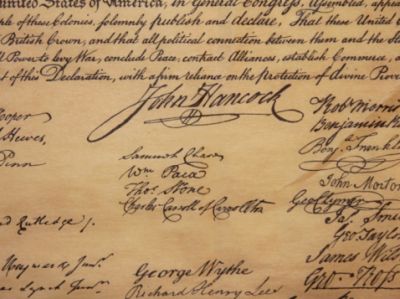
The story behind John Hancock's signature on the Declaration of Independence. (Thinkstock)
It's a neat story about American brashness, but it isn't very accurate. The truth is a tad less dramatic.Snopes.com explains that Hancock, president of the Continental Congress, gave a super-sized signature not because he was itching for a fight with the king, but because, among other things, he happened to be the first person to sign the document.
Because Hancock was the first to sign, he did the sensible thing and put his name front and center. He was the leader of the Congress, after all. He didn't know his fellow patriots would sign their names on a smaller scale.
So, why are some of the other signatures high and to the left while others are down and to the right? The National Archives explains, "In accordance with prevailing custom, the other delegates began to sign at the right below the text, their signatures arranged according to the geographic location of the states they represented. New Hampshire, the northernmost state, began the list, and Georgia, the southernmost, ended it."
And it's worth remembering that signing one's name to the Declaration of Independence was no small thing. Those who signed the document were sure to be hanged for treason should they be caught.
Another popular story says that the members of Congress were inspired to lend their own names to the document after seeing Hancock's epic autograph and the bravery it signified. Neat, but not true. Not only was Hancock the first to sign the Declaration, he did it weeks before anybody else. The National Archives explains, "One of the most widely held misconceptions about the Declaration is that it was signed on July 4, 1776, by all the delegates in attendance."
In reality, Hancock signed it in the presence of just one man, Charles Thomson, the secretary of Congress.National Geographic explains, "no one actually signed the Declaration of Independence at any time during July 1776. Signing began on August 2, with John Hancock's famously bold scribble, and wasn't completed until late November."
That famous painting of all the founding fathers gathered around, signing the document was a case of artistic license.
No comments:
Post a Comment